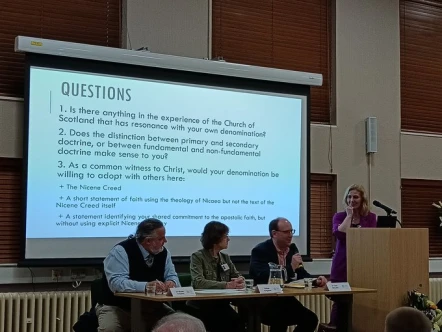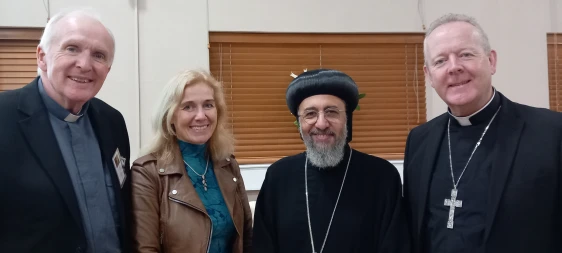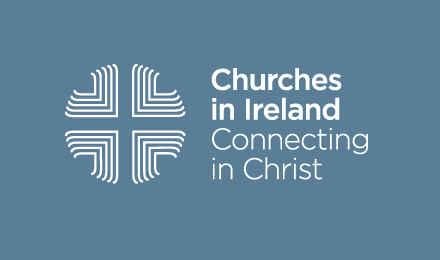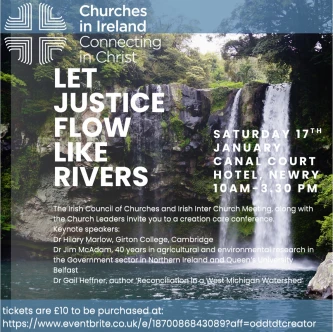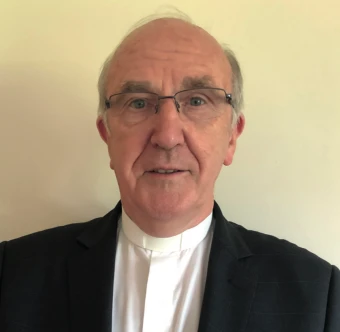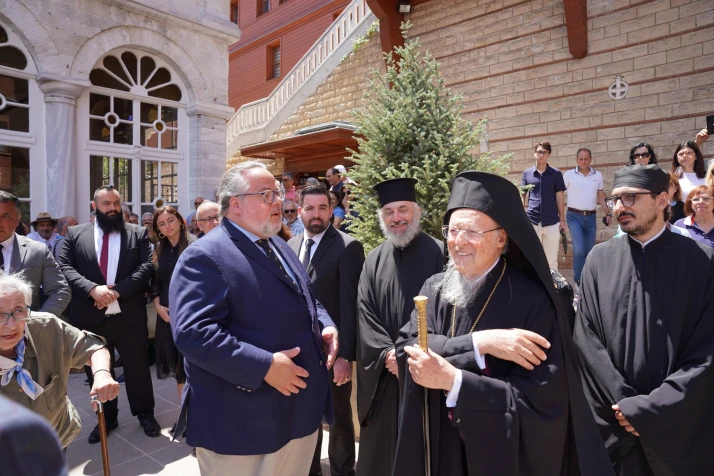
Update Middle East Activities
In June, Dr. Miceál O’Hurley, Metropolitan Secretary of the Greek Orthodox Church visited the oldest continuously occupied monastery in Christendom. A two-and-a-half-hour journey by car from Sharmel Sheikh into the Sinai desert, the Sacred Autonomous Royal Monastery of Saint Catherine of the Holy and God-Trodden Mount Sinai (Greek Orthodox) was established by the Emperor Justinian between 548-565. The ‘Sinai Fathers’ continue their tradition of monastic life to this day. The following is an account of his travels in the Levant to visit Christian communities:
My sojourn across the Levant began in Constantinople where I paid my respects to His All Holiness, Ecumenical Patriarch Bartholomew I. I then journeyed to Egypt as part of my work to assist as part of the legal team addressing a matter concerning the world’s oldest Christian monastery.
In the Spring of 2025, Egypt’s Ismailia Court of Appeals ruled that the Monastery belongs to the Egyptian State based on Egypt’s antiquity laws. The case arose from a challenge claiming monastery, and the attending 47 sites such as the site of the Burning Bush, Aaron’s Church, Moses’ Well, and others over which the Sinai Fathers have held custody for some 1,500 years, did not include legal land registrations and should therefore come under the auspices of the State.
In response to the ruling, Egypt pledged they were bound to abide by the Ismailia Court of Appeals decision. However, Egypt pledged the Sinai Fathers could continue to use the property without interference. The situation erupted in concern for the future of the Christian communities of the Levant struggling to survive. Thanks to a bilateral agreement between the Governments of Greece and Egypt an accord was reached to generally maintain the status quo while the Sinai Fathers challenge the decision on judicial review.
The decision of the Egypt court presents real difficulties. Legal scholars argue that despite the Egyptian constitution’s commitment to treat all religions without discrimination the law of imminent domain has only been imposed on Christian sites while Islamic sites, equally without clear legal title but with notorious continuous use, are not molested. Matters are complicated by Egypt having applied for the Monastery of St. Catherine to be listed as a UNESCO World Heritage Site which was granted in 2002. Arguably, the Ismailia Court of Appeals decision offends the obligations the Egyptian government owes the Sinai Fathers and the UN under the UNESCO agreement.
If these matters were not complex enough, there is the issue of the special role St. Catherine’s plays in the life of the Bedouin people who are the indigenous people of the Sinai desert. As far back as the founding of the monastery, the Brothers have cared for and provided a bridge between the Bedouin and the ‘outside world’. Under Ottoman rule, the Abbot of the monastery was made the custodian of the Sinai Peninsula and was by agreement elevated to the state of an Archbishop to put him on par with other diplomats and governors. St. Catherine’s takes their stewardship obligations to the Bedouin seriously. The Bedouin have complained that their homes and grazing areas have been taken-away by the Egyptian Government as part of their ‘Great Transfiguration Project’ designed to develop the area around Mount Sinai for tourism. Egypt has undertaken significant water, electrical, roadworks and other infrastructure development projects in the region.
Of significant note as part of my visit to St. Catherine’s as part of the legal team assisting the Sinai Fathers was the opportunity to inspect the Āshtīnāmeh (treaty, writ or more properly - reconciliation) issued by the Prophet Mohamed in the year 623 CE. The document, which bares the inked handprint of the Prophet Mohamed himself, guarantees that St. Catherine’s integrity should be observed, that the Sinai Fathers remain un-molested in their duties, worship and observances and their rights to the properties in their charge be acknowledged and go without taxation. There are several copies of the Āshtīnāmeh, many certified over the centuries by Islamic scholars and officials which have been almost universally accepted as genuine until the lawsuit seeking to gain ownership of the monastery was lodged. The Court has declined to rule on the authenticity of the Āshtīnāmeh or Islam’s near 1,400-year-old reliance on its authority.
The Monastery boasts not only a unique collection of icons that survived Iconoclasm because of the near sequestration of the monastery in the harsh Sinai climate and sheer difficulty in reaching it prior to reliable car travel, but a unique library. The desert climate and continuity of the community created conditions for not only the accumulation of ancient texts but their preservation being naturally aided by the arid desert climate. The collection, accessible to scholars and visitors by prior arrangement, includes early Christian manuscripts and even more ancient Greek secular texts including scrolls, parchments and the earliest bound books in Greek, Arabic, Aramaic, Syriac, and Georgian.
Following the visit to St. Catherine of the Sinai Monastery I travelled to Lebanon and Syria to visit communities impacted by war. Some of the communities are the direct beneficiaries of protection provided by Irish Defense Forces as part of the UN Multinational Peacekeeping Forces (UNIFIL). The strain on Christian communities after decades of conflict and un-even protections for Christians in the Levant during this period has been significant. Syria's Christian population has fallen from over 1.8 million in 2011 to approximately 579,000 today, and Iraq's Christian population has declined from around 1.5 million in 2003 to less than 200,000. Other countries in the Levant have also seen significant declines, such as Palestine, where Christians now make up about 1% of the population, down from 11% in 1922.
A powerful experience arose from my visit to Damascus. I met with Brother Francesco Lelpo, OFM Custos of the Holy Land and Guardian of Mount Zion. Our meeting came days after the suicide bomber attack on the Greek Orthodox parish of Mar Elias where 30 Christians were killed and 54 others severely wounded while participating in the Divine Liturgy. Following my visit to Mar Elias a priest gave me a copy of the Bible in Arabic bearing the blood of martyrs who died in the attack along with a brass key that formerly fit the entry door to the Church and a remnant of an icon destroyed in the blast. While visiting Mar Elias gunshots rang out in the neighbourhood demanding the response of armed volunteers who take turns protecting the Church.
When making the gift of these relics, the priest wanted me to take them back to Christians in Ireland so they can bare witness to the continued suffering of the vulnerable Christians in the Middle East. They are currently being curated for preservation. The Bible is now on permanent loan with Christians in the USA. Before leaving Syria, I was able to present a gift of $10,000USD on behalf of the Order of St. George the Great Martyr to the Mar Elias community to assist with medical bills for victims, burial costs and care for the community.
As a final part of my mission I had the opportunity to work with Father Nadim Nassar of the Awareness Foundation. A native of Syria, Father Nadim is a priest of the Church of England who serves as the Executive Director of a non-profit that assists Christian communities in the Middle East. His partnerships with Evangelical Christians, Roman Catholics, Orthodox Christians, Baptists, Presbyterians, Anglicans and others delivers programmes to help children throughout the region. Their ‘Little Heroes’ programme in Homs, Syria provides children educator and counsellor designed programmes for children aged 6-12 including therapeutic teaching, play, art, music, and sports activities alongside help and support tailored to individual needs. Through the Awareness Foundation, children are assisted in recovering from trauma, forge new friendships, celebrate diversity, and build confidence through discovering new skills and talents. This non-denominational, Christian-based NGO’s ‘Little Heroes’ programme goes a long-way in helping children recover their sense of agency, empowerment and nurturing renewed hope for the future.
- Miceál O’Hurley
